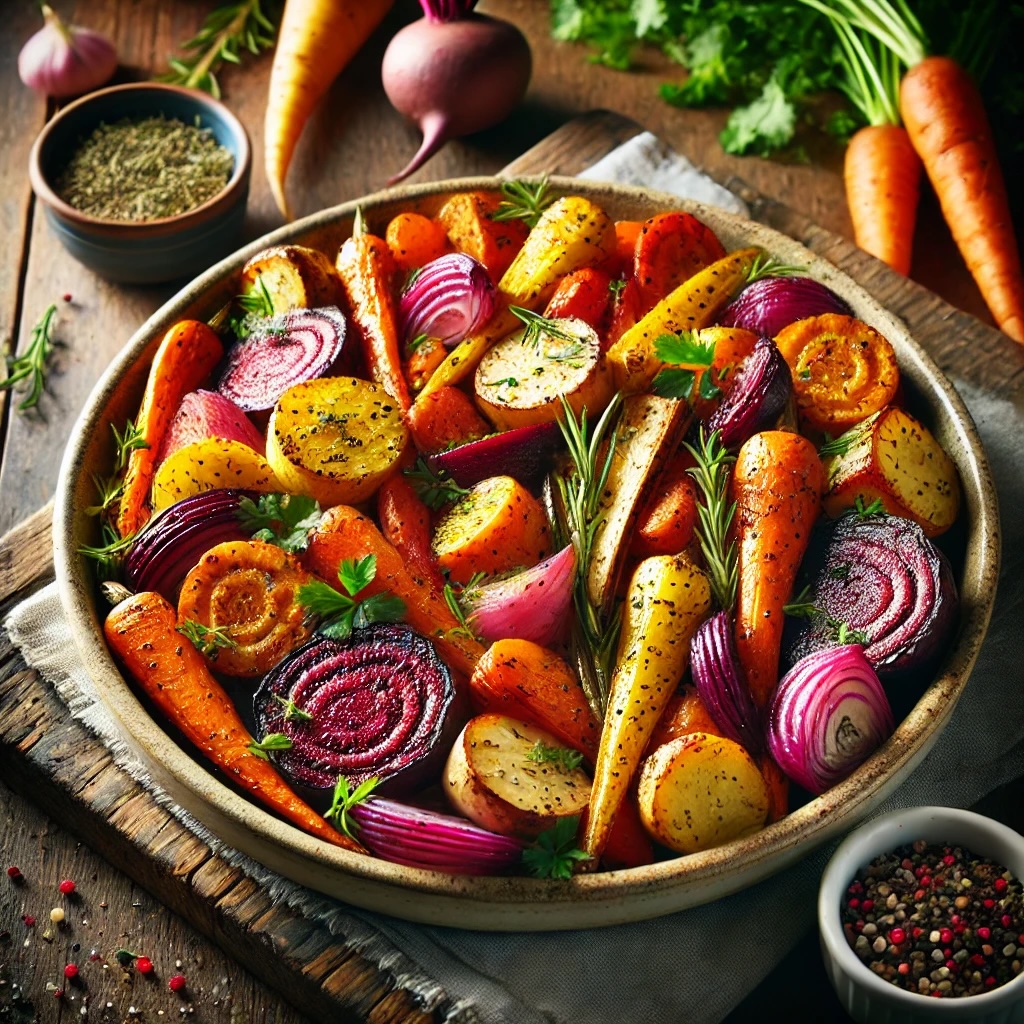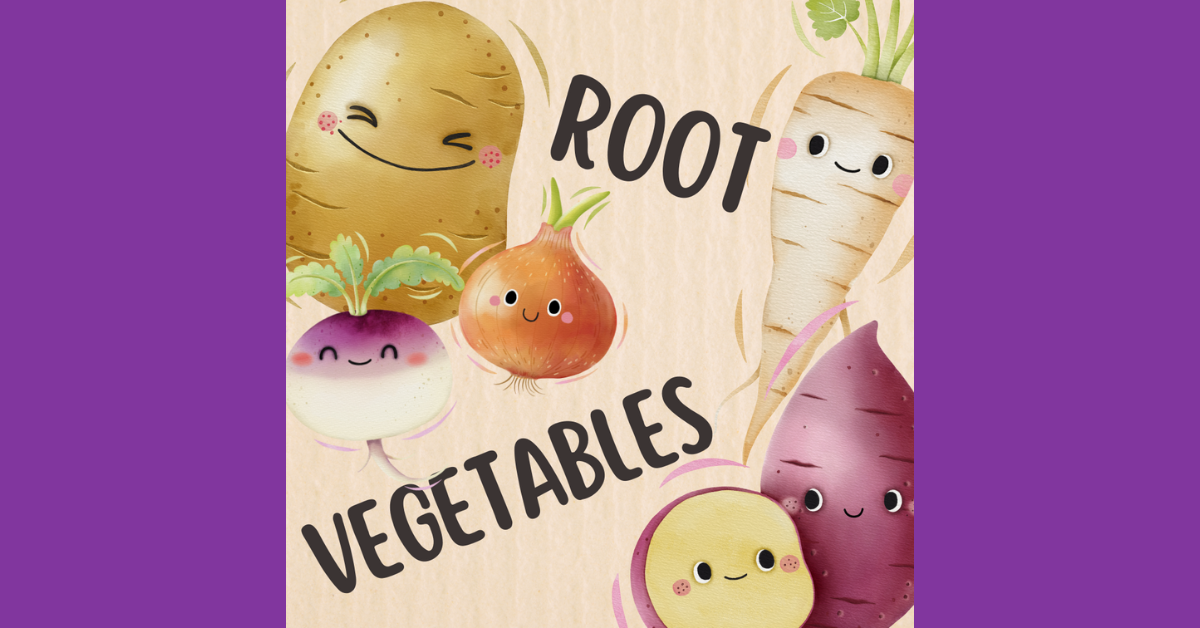Explore the versatility of root vegetables this December. Learn about their nutritional benefits, seasonal availability, and budget-friendly recipes to warm up your winter meals.
As winter settles in, it’s time to embrace the bounty of seasonal produce, especially root vegetables. Even though December is Root Vegetable Month, root vegetables can be enjoyed year-round.
In the United States, cooler weather shifts the focus to hardy crops that thrive in lower temperatures. Root vegetables like carrots, parsnips, turnips, and beets are designed to withstand the chill, making them abundant and affordable during winter. Alongside these, cruciferous vegetables such as kale, cabbage, and Brussels sprouts also shine in December, adding variety to winter meals.
What’s in a Root?
Vegetables are grouped according to the edible part of each plant:
- bulbs (onion, fennel)
- flowers (broccoli, cabbage)
- leaves (lettuce, spinach)
- roots (carrot, parsnip)
- stalks (asparagus, celery)
- tubers (potato)
Consuming fruits and vegetables of any kind is associated with a lower risk of chronic diseases such as heart disease, stroke, and some cancers, and root veggies are no different [1]. As a registered dietitian, I encourage my patients to think of their plates as a canvas for variety. Diversifying our diets not only keeps meals exciting but also ensures we’re giving our bodies the full spectrum of nutrients they need to thrive.
Root vegetables are a perfect example. They’re so versatile and packed with different vitamins and minerals—like those listed below—as well as antioxidants and fiber. Including these veggies provides an easy and delicious way to boost the nutritional value of our meals.
- folate – helps tissues grow and cells function; works with vitamin B12 and vitamin C to help the body break down, use, and create new proteins; helps form red blood cells to prevent anemia
- iron – essential in making hemoglobin protein in red blood cells; help carry oxygen throughout your body; support cognitive and immune function
- manganese – plays a role in bone formation, blood clotting, and reducing inflammation
- pantothenic acid (aka vitamin B5) – supports blood cell production; converts food to energy
- potassium – helps your nerves, muscles, heart to function well; helps move nutrients and waste around your body’s cells)
- riboflavin (aka vitamin B2) – works with the other B vitamins for body growth; helps in red blood cell production; aids in the release of energy from proteins
- vitamin A (aka retinol) – helps form and maintain healthy teeth, skeletal and soft tissue, mucus membranes, and skin; promotes good eyesight, especially in low light; also plays a role in healthy pregnancy and breastfeeding
- vitamin B6 – supports immune function; keeps the nervous and immune systems healthy; important for metabolism
- vitamin C – needed for the growth and repair of tissues in all parts of your body; used to form collagen—skin, tendons, ligaments, and blood vessels; heals wounds and forms scar tissue
- vitamin K – helps heal injuries through blood clotting; strengthens bones)
- zinc – plays a key role in skin health; supports immune function; encourages cell growth
The more we experiment with these earthy vegetables, whether roasted, mashed, or blended into soups, the more we can explore flavors and textures that appeal to our personal preferences. By mixing and matching different root vegetables with other seasonal produce, we make it that much easier to meet our daily nutritional goals while enjoying a colorful, nutrient-rich diet.

The Beauty of Seasonal Eating
Eating seasonally is a fantastic way to enjoy foods at their peak flavor while supporting local farmers and keeping grocery costs manageable [1]. Currently, most root vegetables like carrots, beets, potatoes, and turnips are relatively inexpensive, typically ranging from $1 – $3 per pound depending on your location and the specific vegetable, with bulk buying often offering even better prices.
When it comes to eating fruits and vegetables, the average U.S. diet falls short of our daily dietary recommendations. According to the 2020–2025 Dietary Guidelines for Americans, about 90% of the U.S. population does not meet the recommendation for vegetables [2]. December’s produce offers a vibrant mix of flavors and nutrients, with root vegetables being especially noteworthy as they go very well with other foods that are also available at this time, like cruciferous vegetables (kale, Brussels sprouts, cabbage).
Incorporating root vegetables into your meals is an excellent way to meet daily vegetable recommendations, which are vital for optimal health. For those who don’t dig vegetables (I was one of you, believe it or not)), root vegetables offer countless ways to enhance flavor and texture. From roasting with a drizzle of olive oil and spices to puréeing into soups or mashing with garlic for a comfort-food twist, the possibilities are endless. You can even add grated root veggies to baked goods (hello, carrot cake!) or toss them into stir-fries for a subtle crunch. Experimenting with different cooking methods, like steaming or slow-roasting, and adding herbs, citrus, or a touch of honey can transform root vegetables into dishes that please even the pickiest eaters.

Easy and Budget-Friendly Recipes
Incorporating root vegetables into your meals doesn’t have to be complicated or expensive. Here are a few ideas:
- Roasted Root Vegetable Medley [3]
Toss carrots, parsnips, beets, and onions with olive oil, rosemary, and thyme. Roast 400°F (200°C) for 30-40 minutes or until caramelized for a perfect side dish. - Sweet Potato and Kale Soup
Combine diced sweet potatoes, kale, garlic, and vegetable broth. Bring to a boil for 5 minutes, then reduce heat and simmer until sweet potatoes are tender (about 15-20 minutes). Blend for a creamy, comforting soup. - Carrot and Turnip Mash
Boil carrots and turnips in a pot of salted water until tender, about 15-20 minutes, then mash them with a little butter and salt for a lighter, nutrient-packed twist on traditional mashed potatoes.
The Final Word on Winter’s Bounty
Root vegetables and other seasonal produce are a celebration of flavor, nutrition, and sustainability. By eating seasonally, you can enjoy the freshest foods while connecting with your local food system. So, next time you’re at the market, stock up on these winter gems and get creative in the kitchen [4]!
JOIN US!
If you’re reading this before December 5, 2024, click here to join our FREE, live webinar to learn more about the health benefits of incorporating root vegetables into our diets, shopping for seasonal produce, and creating easy & affordable recipes. As always, registrants will receive a link to the recording after the event, so don’t worry if you can’t attend the live event. Or you can head to our Wellness Webinar playlist on DishWithDinaTV to check out past events on similar topics.
References
- The pros and cons of root vegetables
- For Supplemental Nutrition Assistance Program (SNAP) Households, Fruit and Vegetable Affordability Is Partly a Question of Budgeting
- Did you know there are three main types of carbohydrate (or carbs) in food?
- 89 Ways to Cook With Root Veggies That Go Beyond Roasting
- healthline.com – 17 Creative Ways to Eat More Vegetables



0 Comments